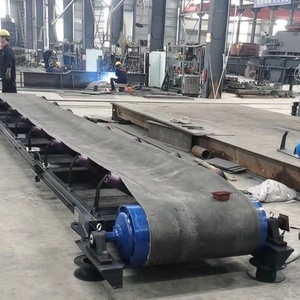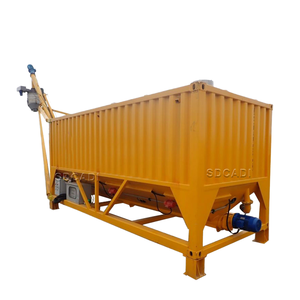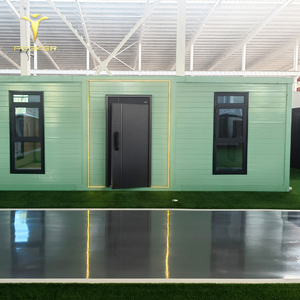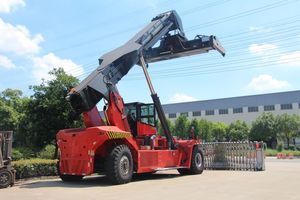(8139 products available)




























































































































































































Container loading systems come in various types based on the nature of the cargo and the efficiency required during the loading process. Below are the predominant types:
Manual Loading Systems
In manual loading systems, workers physically load containers, often using basic hand tools and equipment like forklifts, pallet jacks, and conveyors. While this method is resource-intensive and time-consuming, it allows for flexibility, particularly in environments where cargo type and volume can fluctuate significantly.
Automated Loading Systems
Automated loading systems employ machines, such as conveyor belts, robotic arms, and automatic guided vehicles (AGVs), to load containers. This method boosts productivity, accuracy, and safety by minimizing manual labor, particularly in large-scale operations where vast volumes of goods are handled consistently. As a result, automated systems are especially beneficial in manufacturing and distribution networks, characterized by high throughput and uniformity in cargo type.
Pneumatic Loading Systems
Pneumatic loading systems use air pressure to transfer bulk materials, particularly suitable for powders and granules. This technique is clean and reduces the physical demands on labor, particularly valuable in industries such as food processing, pharmaceuticals, and agriculture, where maintaining product integrity is essential. Moreover, the ability to load from a distance, especially in dusty or hazardous environments, adds to its appeal.
Mechanical Loading Systems
Mechanical loading systems employ tools like screw conveyors, bucket elevators, and vibratory feeders to load bulk materials into containers. These are particularly beneficial for materials like grains, coal, and minerals. Also, mechanical systems can be designed with varying degrees of automation, contributing versatility to operations ranging from small to large-scale mining and agriculture.
Vacuum Loading Systems
These systems use vacuum pressure to transport bulk materials, particularly suitable for fragile items like powdered food and chemicals. The system not only protects the material from damage but also provides a hygienic loading process, making it ideal for industries like pharmaceuticals, food processing, and chemicals. The gentle handling and efficient dust control are key benefits in sensitive material management.
Logistics and Transportation
Container loading systems are critical to logistics and transportation, ensuring freight enjoyed a swift, safe, and efficient process. Mostly, the systems' automatic features help decrease the time taken to load and unload containers, improve cargo handling capacity, and minimize manual errors. This is especially important in the shipping industry, where delays can result in considerable costs. In the intermodal transportation systems, for example, containers can seamlessly transition between trucks, trains, and ships, enhancing supply chain efficiency.
Manufacturing
Container loading systems are also used broadly in the manufacturing industry, where raw materials and finished goods need to be transported regularly. For instance, automated systems can load products into containers directly from the production line, minimizing handling time and boosting productivity. In industries that deal with bulk materials, like chemicals and minerals, mechanical and pneumatic systems are particularly beneficial due to their speed and efficiency in handling large quantities of goods.
Agriculture
In agriculture, container loading systems are used to transport grains, feedstock, and other bulk agricultural goods. Vacuum and mechanical loading systems are extensively used here to handle delicate materials while either preventing spoilage or ensuring minimal damage during the loading process. Container systems are critical to enhancing operations in this sector and improving the speed and efficiency with which products are transported to the market, thereby increasing profitability.
Construction
Loading systems are crucial for transporting concrete, aggregates, and other building materials. Also, mechanical loading systems ensure these materials are loaded into containers or onto vehicles quickly, helping productivity and reducing the time it takes to transport materials to and from construction sites. Furthermore, with a high emphasis on efficiency in the ever-competitive construction industry, developing effective and speedy loading systems has become hugely beneficial.
Retail and Distribution Centers
Still, container loading systems are essential for retail and distribution centers. Here, the swift movement of goods is an integral part of operational success, hence how automated loading systems help facilitate loading trucks and shipping containers. These systems improve order fulfillment by reducing manual labor and minimizing the errors associated with the process of loading. Also, with the rising demand for e-commerce, the role of these systems in helping enhanced logistics efficiency has become more critical.
Loading Capacity
Loading capacity ranges from small-scale operations with a few tons daily to large industrial plants that require thousands of tons. Ideally, the capacity is often determined by the size of the container in use and the nature of the material being loaded. Whether bulk or itemized cargo, a container loading system must handle the required material volume seamlessly.
Speed
Loading speed is a critical factor, designed to minimize the time taken to fill each container and hence increase operational efficiency. Usually, systems designed for high-volume industries come with high-speed capabilities, while those that emphasize flexibility might trade speed for adaptability to varied container sizes and shapes.
Automation Level
Automation levels in container loading systems can range from fully automated operations to semi-automated or purely manual work. Fully automated systems employ robots to load and handle containers, which is sufficient in operations that require large volumes of work and where tasks are repetitive. Semi-automated systems normally reduce manual handling but still require some level of human intervention.
Compatibility with Container Sizes
Container loading systems should be adaptable to various container sizes and standards. Depending on the industry, these systems may need to accommodate standard shipping containers, cargo tanks, or custom-built containers. This is especially important if a business transports different types of goods, as a versatile loading system helps obviate the need for multiple pieces of equipment.
Apart from being compatible with container sizes, these systems should also withstand a variety of environmental conditions like temperature, humidity, or exposure to chemicals. Systems designed for outdoor usage such as in construction or agricultural sectors come with protective casings for added resistance to the elements.
Safety Features
The safety features included in the container loading systems have to be in place to protect both the equipment and the personnel. These include emergency stop buttons, overload sensors, and protective enclosures for mechanical parts. Occupational health hazards can be minimized by incorporating safety features into the system, which also ensures loading processes remain uninterrupted.
Maintenance Requirements
This is extremely important in ensuring the system it continuously runs efficiently. Maintenance requirements, for instance, involve routine checks on mechanical parts, lubrication of moving pieces, and diagnostics on automated components. In industries that deal with bulk materials, the systems experience a lot of wear and tear, so designing them with ease of maintenance in mind becomes critical.
Additionally, sophisticated new systems come with sensing and monitoring tools that provide real-time data on system performance, which can then be used proactively for maintenance and optimization.
Automated systems give rise to access control units that help limit movement within the work environment while automated guided vehicles or robotic arms, for instance, can operate unhindered. Still, combining security and efficiency makes these systems paramount in maintaining operational safety and achieving seamless productivity.
Sensors and IoT Devices
IoT devices and sensors allow for real-time data collection, which managers can use to improve and make decisions on Container Loading Systems. Those things range from monitoring loading speeds, container weights, and system malfunctions; these sensors provide information needed to optimize processes fully. Overall, integrating IoT into container loading systems stirs up an entire level of efficiency unto the operations.
Energy-Efficient Upgrades
These upgrades, such as regenerative braking systems for electric equipment and solar power integration, reduce energy consumption and operational costs. Given the increasing importance of sustainability in all business practices, investing in energy-efficient loading systems contributes to greener operations while decreasing expenditures.
Docking Solutions
Differently, that would include hydraulic and pneumatic buffers, levelers, and sealing solutions improving loading and reducing loss possibilities. These solutions come with the added benefit of reducing the time taken in the docking process and ensuring safety and efficiency, hence making their importance to operations impossible to overemphasize.
Quality Materials
Container loading systems demand frequent contact with various materials; thus, sturdily-built systems mean those with high-quality material-derived components. Steel with a high tensile strength, for instance, makes ideal material-loading mechanisms, while corrosion-resistant materials are well-suited for handling chemicals or wet materials. The longevity and reliability of a system also increase significantly with the use of premium materials.
Durability
Durability and reliability of container loading systems directly impact operational efficiency. Usually, a more durable system is one that can treat itself with varying intensities and harsh weather elements without needing overhaul or repairs frequently. Therefore, besides premium material usage, systems in enclosed environments are usually more robust and well-engineered to withstand wear and tear, have better durability, and thus maintain production without failure.
Regular Inspection
Regular and close examination of performance means that any faults are identified and fixed early, which leads to long preventative work being done on the equipment. As an example, checking all major components housed in mechanical parts for signs of wear are key to pre-emptive maintenance scheduled. Inspections improve the life of the system and help assure that it runs as effectively as possible.
Corrective Maintenance
A major focus should be placed on corrective maintenance when system components fail or when performance drops below the desired levels set. That would involve repairing or replacing damaged parts, for example, during the breakdown of contained systems. While it can be time-consuming and, in more severe cases, results in costly downtimes, prompt maintenance still has to be done to return systems to optimal performance levels.
Operator Training
Thus, training programs ensure that staff understand how to operate items safely and efficiently, but this does away with machine misuse and low productivity. New technologies such as automated and IoT-integrated systems come along with varying operation techniques; a well-trained workforce can then be employed to handle these systems properly. This minimizes maintenance issues due to bad handling and maximizes the containers' loading system potential.
Efficiency
They entail speedy operations to minimize the time taken to load or unload the container, mainly for automated systems. This makes huge steps for logistics firms in loading times as it directly influences cost and overall productivity. In Manufacturing, higher efficiency rates come with lower operational costs and higher output rates.
Safety
Containment loading systems normally incorporate extensive safety protocols to protect the workforce and cargo from accidents. Also, safety features, including emergency shut-off, overload sensors, and guarding, help decrease workplace risks. As safety standards keep changing, container loading systems evolve to meet these standards, promoting safer work environments and minimizing injury chances.
Flexibility
Some container loading systems can accommodate various container types and sizes with distinct loading materials, whether bulk or packaged. This is most valuable in industries where product types keep changing since the system can handle such demand without going through an overhaul. That adaptability means that companies do less by investing in one integrated solution for various operations.
Integration Capabilities
Container loading systems come with the capacity to be integrated into the existing supply chain and logistics processes, in particular with inventory management and warehouse control systems. Besides, IoT technologies integrated into the system make real-time data gathering possible, which can be used for optimization. These systems contribute to better overall efficiency by facilitating better communication and coordination between operations.
Durability
Since container loading systems handle intensive workloads and, in most cases, in pretty harsh environments, their materials need to be highly durable. Thus, quality components such as reinforced steel and wear-resistant materials contribute to this long system life and, correspondingly, reliability. More durable systems end up requiring less maintenance and replacement, thus adding to their cost-effectiveness over time.
Pneumatic Systems do load bulk materials using air pressure, which is especially useful for powders or fragile materials like grains. These are favored in the food, chemicals, and pharmaceuticals industries because of their efficiency in handling hazardous materials and maintaining cleanliness.
h4>Q. How do Container Loading Systems contribute to operational safety?For instance, they include emergency stops, overload protection, and guarded mechanical parts that will decrease workplace accidents. Container loading systems ensure loading processes are safe by addressing potential hazards and improving efficiency in the loading process.
h4>Q. What features do Container Loading Systems have that increase their lifespan?Ideally, quality materials such as steel with enhanced tensile strength and components designed for easy repairs contribute to their durability. Besides, regular inspections and preventive maintenance can identify potential failures early on to extend the system's life.
An automated container loading system is a significant advantage: operational efficiency. Usually, automation minimizes manual handling, which further reduces errors and time delays. Therefore, it is especially beneficial to high-demand environments such as logistics, manufacturing, and distribution where larger cargo volumes are to be handled consistently.
The noise can be minimized by incorporating soundproofing materials into the design of the system. While system placement does play a huge role in lowering its impact, using noise-isolating mounts and enclosures reduces much of the noise generated during the system's operation.
Thus, regular inspections, lubrication of moving parts, and timely repairs of worn components ensure the smooth running of container loading systems. Additionally, operators should receive proper training to help avoid mistakes during the operation that might cause wear and tear; preventive maintenance keeps systems running optimally.
Mechanical systems use machines such as screw conveyors and bucket elevators to move bulk materials. These solutions are particularly advantageous for high-volume products such as grains, coal, and minerals since they enhance speed and efficiency in the container loading process.